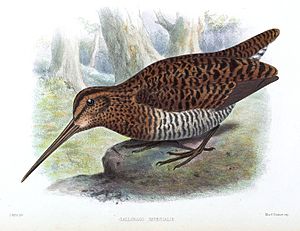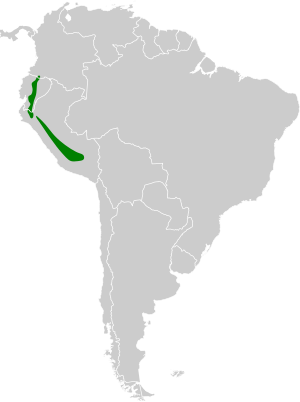Imperial snipe facts for kids
Quick facts for kids Imperial snipe |
|
|---|---|
 |
|
| Conservation status | |
| Scientific classification | |
| Genus: |
Gallinago
|
| Species: |
imperialis
|
 |
|
The imperial snipe (Gallinago imperialis) is a special bird that lives in the Andes mountains. It's a type of wader, which means it often lives near water. For a long time, people thought this bird was extinct, meaning it had disappeared forever. But then, it was found again in Peru in 1967 and Ecuador in 1988! Scientists are still learning if these birds travel long distances, like other migratory birds.
Contents
What the Imperial Snipe Looks Like
This bird is about 29 to 31 centimeters long. It has a strong body and legs that are quite short for a wader. Its feathers are mostly a dark reddish-brown color. But its lower belly and the feathers under its tail are white with thick brown stripes.
The imperial snipe has a long, straight, and strong grey beak. Its legs and feet are also grey. Male and female imperial snipes look very much alike. We don't know much about what young imperial snipes look like. However, in most snipe species, young birds are similar to adults, but they might have lighter edges on their wing feathers.
Flying and Singing
When the imperial snipe flies, it looks heavy. It has wide wings and a short tail. Its striped belly stands out against its dark chest and the underside of its wings.
This bird has a very loud and rough song. It sings during its special display flight. The song starts with single notes and then changes to double or triple notes.
Comparing with Other Snipes
The imperial snipe is much bigger than the Magellan snipe. The Magellan snipe has clear light stripes on its back. It also doesn't have stripes on its lower belly like the imperial snipe. The Magellan snipe found in the Andes also has yellow legs.
The Andean snipe (Gallinago jamesoni) looks similar to the imperial snipe. But the Andean snipe has lighter feathers on its throat and under its wings. Its lower belly also has less contrast in its markings.
How the Imperial Snipe Behaves
The imperial snipe lives high up in the mountains, near the tree line. This is usually between 2,745 and 3,700 meters high. They live in places that have a mix of bogs, mossy areas, moist forests, tree-ferns, and tall grass.
We don't know much about their daily habits. People mostly see them when they are performing their special display flights.
Display Flights
At dawn and dusk, the imperial snipe flies high in circles. During this flight, it sings its extremely loud song. After singing, the bird dives down. As it dives, it makes a special "drumming" sound. This sound comes from the vibrations of its unique outer tail feathers.
What They Eat
We don't know exactly what the imperial snipe eats. But other types of snipes use their long beaks to search for insects and worms in the ground. They do this by poking their beaks into the soil.
Status and Protection
For more than 50 years, people thought the imperial snipe was extinct. But now, it has been found in at least six places in Peru and twelve places in Ecuador. It seems to live on both the east and west sides of the mountains in Ecuador, and on the east side in Peru.
However, there aren't many of these birds. Only about 4 to 5 displaying birds might be found in a 1.6 square kilometer area of good habitat. The known groups of these birds are small and found only in certain spots.
Threats to Their Home
The places where the imperial snipe lives have been harmed by human activities. People sometimes burn the land or let animals graze there. Also, some areas are being turned into farms. These changes make it harder for the snipes to find suitable homes.
But if more and more imperial snipes are found, and in more places, their conservation status might improve. They could be reclassified to "Least Concern," which means they are not as much at risk.
See also
 In Spanish: Agachadiza imperial para niños
In Spanish: Agachadiza imperial para niños


